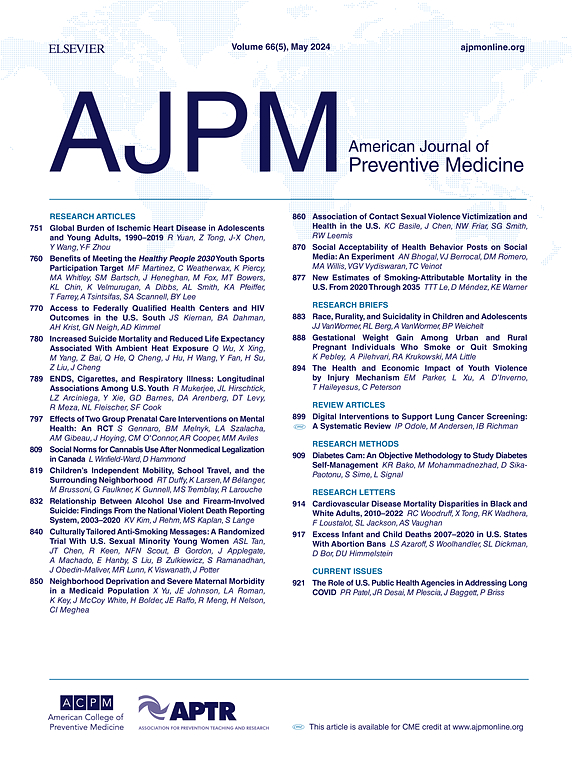握力不对称与多种健康结果的关系
IF 4.3
2区 医学
Q1 MEDICINE, GENERAL & INTERNAL
引用次数: 0
摘要
简介:握力不对称(GSA)与心血管、呼吸、癌症结局和全因死亡率之间的关系尚不清楚。方法:在2006-2010年的443132名英国生物银行参与者中,GSA被定义为左手握力(kg)与右手握力(kg)的比值1.1。采用Cox比例模型评估GSA与心血管、呼吸、癌症结局和全因死亡率的关系。评估净重分类改善,以评估在将GSA添加到具有已建立的基于办公室的风险因素的模型后,结果的风险歧视改善情况。结果:平均随访12.1年,共发生28478例(6.4%)死亡。GSA与全因相关(风险比[HR]: 1.096;95%ci: 1.070, 1.122),心血管疾病(hr: 1.141;95%CI:1.071, 1.216),呼吸系统疾病(HR: 1.183;95%ci:1.076, 1.301), copd (hr: 1.284;95%CI: 1.087, 1.516)和癌症(HR: 1.051;95%CI: 1.017, 1.086)。GSA与CVD有显著相关性(HR: 1.029;95%CI: 1.004, 1.054),呼吸系统疾病(HR: 1.074;95%ci: 1.051, 1.103), copd (hr: 1.123;95%CI: 1.038, 1.215)和结直肠癌(HR: 1.051;95%CI: 1.037, 1.066)。此外,将GSA添加到已建立的基于办公室的危险因素的模型中,可显著提高预测全因、心血管疾病和呼吸系统疾病死亡率的能力。结论:GSA与一系列不良健康结果相关,可能在预测全因、心血管疾病和呼吸系统疾病死亡率方面具有临床应用价值。需要进一步的工作来验证GSA评估的临床价值。本文章由计算机程序翻译,如有差异,请以英文原文为准。
Associations of Grip Strength Asymmetry With Multiple Health Outcomes
Introduction
The relationships between grip strength asymmetry and cardiovascular, respiratory, and cancer outcomes and all-cause mortality remain unclear.
Methods
Among 443,132 UK Biobank participants enrolled from 2006 to 2010, grip strength asymmetry was defined as the ratio of left-hand grip strength (kg) to right-hand grip strength (kg) <0.9 or >1.1. The Cox proportional model was employed to assess the associations of grip strength asymmetry with cardiovascular, respiratory, and cancer outcomes and all-cause mortality. Net reclassification improvement was assessed to evaluate the improvement in risk discrimination for outcomes after adding grip strength asymmetry to the model with established office-based risk factors.
Results
After a mean follow-up of 12.1 years, 28,478 (6.4%) deaths occurred. grip strength asymmetry was significantly associated with all-cause (hazard ratio: 1.096; 95% CI=1.070, 1.122), cardiovascular disease (hazard ratio: 1.141; 95% CI=1.071, 1.216), respiratory disease (hazard ratio: 1.183; 95% CI=1.076, 1.301), chronic obstructive pulmonary disease (hazard ratio: 1.284; 95% CI=1.087, 1.516), and cancer (hazard ratio: 1.051; 95% CI=1.017, 1.086) mortality. Significant associations of grip strength asymmetry with cardiovascular disease (hazard ratio: 1.029; 95% CI=1.004, 1.054), respiratory disease (hazard ratio: 1.074; 95% CI=1.051, 1.103), chronic obstructive pulmonary disease (hazard ratio: 1.123; 95% CI=1.038, 1.215), and colorectal cancer (hazard ratio: 1.051; 95% CI=1.037, 1.066) incidence were observed. Moreover, adding grip strength asymmetry to a model with established office-based risk factors significantly improved the ability to predict all-cause, cardiovascular disease, and respiratory disease mortality.
Conclusions
Grip strength asymmetry was associated with a range of adverse health outcomes and may have clinical use in predicting all-cause, cardiovascular disease, and respiratory disease mortalities. Further studies are warranted to validate the clinical value of the grip strength asymmetry assessment.
求助全文
通过发布文献求助,成功后即可免费获取论文全文。
去求助
来源期刊

American Journal of Preventive Medicine
医学-公共卫生、环境卫生与职业卫生
CiteScore
8.60
自引率
1.80%
发文量
395
审稿时长
32 days
期刊介绍:
The American Journal of Preventive Medicine is the official journal of the American College of Preventive Medicine and the Association for Prevention Teaching and Research. It publishes articles in the areas of prevention research, teaching, practice and policy. Original research is published on interventions aimed at the prevention of chronic and acute disease and the promotion of individual and community health.
Of particular emphasis are papers that address the primary and secondary prevention of important clinical, behavioral and public health issues such as injury and violence, infectious disease, women''s health, smoking, sedentary behaviors and physical activity, nutrition, diabetes, obesity, and substance use disorders. Papers also address educational initiatives aimed at improving the ability of health professionals to provide effective clinical prevention and public health services. Papers on health services research pertinent to prevention and public health are also published. The journal also publishes official policy statements from the two co-sponsoring organizations, review articles, media reviews, and editorials. Finally, the journal periodically publishes supplements and special theme issues devoted to areas of current interest to the prevention community.
 求助内容:
求助内容: 应助结果提醒方式:
应助结果提醒方式:


